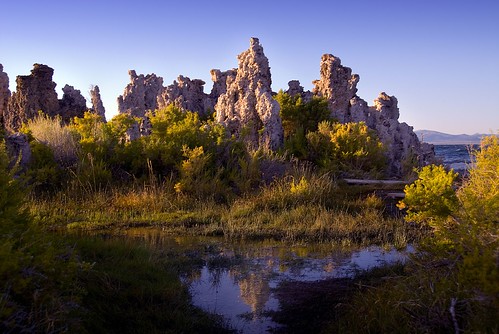Nature created the tufa towers in Mono Lake by combining the carbonates found in salty lake water with the calcium found in nearby freshwater springs. The tufa towers are composed of calcium carbonate, and formed when a freshwater spring wells up through the salty Mono Lake, which is highly alkaline and rich in carbonates.
Julian and I visited the South Tufa area at sunset. From a distance, Julian thought that the fantastic knobs and spires of the tufa towers were some giant’s sandcastle. Closer up, Julian wanted to build his own sand structures on the beach of the inland sea that is Mono Lake while I took photos.
Starting in 1941, the city of Los Angeles began draining water from Mono Lake for its lawns and swimming pools. By the 1980s, water levels had become so low that the ecosystem was seriously in danger. For example, islands used by nesting birds were now connected to the mainland, and could be accessed by predators.
In 1994, after 16 years of court battles, an agreement between Los Angeles and environmental organizations was reached that stabilized the water level at 6,392 feet above sea level for twenty years (until 2014 that is).
In light of this recent history, it’s good to see that the heavy snowmelt of the last two seasons has raised the level of the lake, so that waves now lap over the boardwalks and the information signs in the South Tufa area. Although of course there is a great deal of work still to be done to preserve the wonders of this very special place.
This photo was triple processed from the RAW, once for the sky and tufa, once for the foreground, and once for the reflection in the puddle. I used layer masks and the Paintbrush tool to combine these different exposures in Photoshop.

Pingback: Photoblog 2.0: » Photoblog 2.0 Archive: » Mono Lake Sunset
Pingback: Photoblog 2.0: » Photoblog 2.0 Archive: » When Virtual Worlds Collide